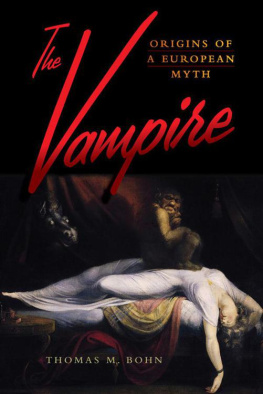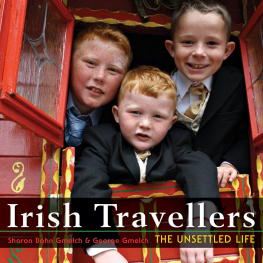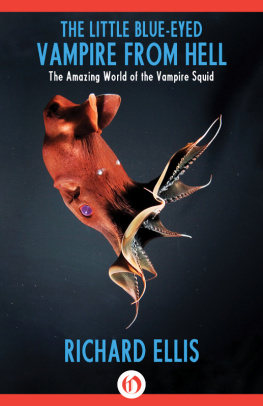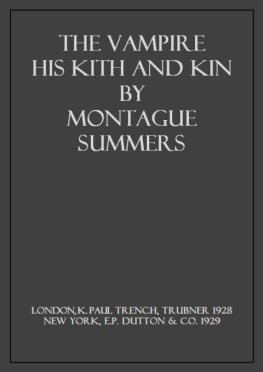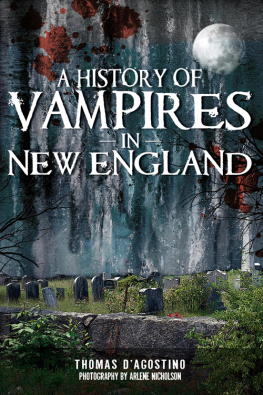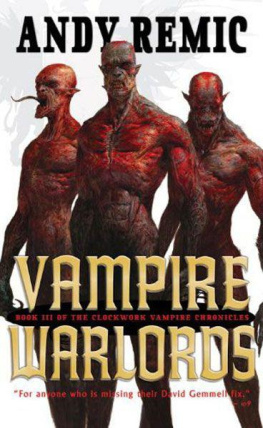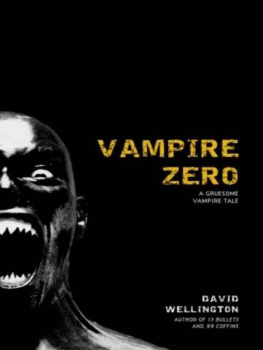Thomas M. Bohn - The Vampire
Here you can read online Thomas M. Bohn - The Vampire full text of the book (entire story) in english for free. Download pdf and epub, get meaning, cover and reviews about this ebook. year: 2019, publisher: Berghahn Books, genre: Detective and thriller. Description of the work, (preface) as well as reviews are available. Best literature library LitArk.com created for fans of good reading and offers a wide selection of genres:
Romance novel
Science fiction
Adventure
Detective
Science
History
Home and family
Prose
Art
Politics
Computer
Non-fiction
Religion
Business
Children
Humor
Choose a favorite category and find really read worthwhile books. Enjoy immersion in the world of imagination, feel the emotions of the characters or learn something new for yourself, make an fascinating discovery.
- Book:The Vampire
- Author:
- Publisher:Berghahn Books
- Genre:
- Year:2019
- Rating:5 / 5
- Favourites:Add to favourites
- Your mark:
- 100
- 1
- 2
- 3
- 4
- 5
The Vampire: summary, description and annotation
We offer to read an annotation, description, summary or preface (depends on what the author of the book "The Vampire" wrote himself). If you haven't found the necessary information about the book — write in the comments, we will try to find it.
The Vampire — read online for free the complete book (whole text) full work
Below is the text of the book, divided by pages. System saving the place of the last page read, allows you to conveniently read the book "The Vampire" online for free, without having to search again every time where you left off. Put a bookmark, and you can go to the page where you finished reading at any time.
Font size:
Interval:
Bookmark:
THE VAMPIRE
THE VAMPIRE
Origins of a European Myth

Thomas M. Bohn
Translated from the German by Francis Ipgrave

First paperback edition published in 2022 German-language edition 2016 Bhlau Verlag GmbH & Cie, Kln Originally published in German as Der Vampir. Ein europischer Mythos All rights reserved. Except for the quotation of short passages for the purposes of criticism and review, no part of this book may be reproduced in any form or by any means, electronic or mechanical, including photocopying, recording, or any information storage and retrieval system now known or to be invented, without written permission of the publisher. Library of Congress Cataloging-in-Publication Data
Names: Bohn, Thomas M., author. | Ipgrave, Francis translator.
Title: The Vampire: Origins of a European Myth / Thomas M. Bohn; translated from the German by Francis Ipgrave.
Other titles: Der Vampir. English.
Description: English-language edition. | New York: Berghahn Books, 2019. | Originally published in German as Der Vampir. Ein europischer MythosT.p. verso. | Includes bibliographical references and index. |
Identifiers: LCCN 2019019138 (print) | LCCN 2019020766 (ebook) | ISBN 9781789202922 (hardback: alk. paper) | ISBN 9781789202939 (ebook)
Subjects: LCSH: VampiresEurope. | FolkloreEurope.
Classification: LCC GR830.V3 (ebook) | LCC GR830.V3 B6413 2019 (print) | DDC 398.210094dc23
LC record available at https://lccn.loc.gov/2019019138
British Library Cataloguing in Publication Data A catalogue record for this book is available from the British Library ISBN 978-1-78920-292-2 hardback ISBN 978-1-80073-433-3 paperback ISBN 978-1-78920-293-9 ebookIf we were to be completely open-hearted in stating our opinion, we would advise against all measures which have the whiff of superstition. It is best that one works towards a genuine reconciliation with the dying person, and forgets all previous adversities since, in this manner, they will fall to sleep with a reconciled heart, and will not lust after anything further in this world. Their fantasies remain dormant and, in the absence of a cause, they can never begin to work upon a living person.
Michael Ranft, 1732

Contents

Illustrations
Maps
The Military Frontier and sites of vampirism in Central, Eastern and Southeastern Europ
Belief in nachzehrers and vampire conceptions in East Central Europe
Figures
Skeletons in a graveyard chase off a knights assailants
St Catherine of Siena Drinking from the Side Wound of Christ
The dead struck the people of Polotsk
Putrid liquid oozing from a swollen corpse
Visum et Repertum, the Flckinger report
Extract from the Flckinger report with the lettering Arnond Paole
Arnond Paole as a pandur?
Vampire treatises from the Enlightenment era
Michael Ranfts Tractat von dem Kauen und Schmatzen der Todten in Grbern ( Treatise on the Chewing and Chomping of the Dead in Graves ) and the motto Mortuus non mordet (The Dead Do Not Bite)
Carl Ferdinand von Schertz Magia posthuma ( Post-mortal Sorcery )
Augustin Calmets Trait sur les apparitions des esprits et sur les vampires, ou les revenans de Hongrie, de Moravie, & c. ( Learned Treatment of Material, on the Appearance of Spirits, and of Vampires in Hungary, Moravia )
Georg Tallars Visum repertum anatomico-chirurgicum ( Anatomical-Chirurgical Report )
Vampyrism by Herrn Baron Gerhard van Swieten
Michael Caspareck, who continues to wander following his death in Hungary
The execution of a vampire in a booklet for enlighteners and non-enlighteners
Festival of Souls in Bosnia
Vuji discusses vampires with monks from the Monastery of Klisura
Table
Published works on vampires between 1732 and 1733

Prologue
From Original Sin to Eternal Life
F or a broad contemporary public, the vampire has become a star, a media sensation from Hollywood. Bestselling authors such as Bram Stoker, Anne Rice and Stephenie Meyer continue to fire the imaginations of young and old alike, and bloodsuckers have achieved immortality through films like Dracula , Interview with a Vampire and Twilight . It is no wonder that, in the teenage bedrooms of our globalized world, vampires even steal the show from Harry Potter. They have long since been assigned individual personalities and treated with sympathy. They may possess superhuman powers, but they are also burdened by their immortality and have to learn to come to terms with their craving for blood. Whereas the Southeast European vampire, discovered in the 1730s, underwent an Americanization and domestication in the media landscape of the twentieth century, the creole zombies that first became known through the cheap novels and horror films of the 1920s still continue to serve as brainless horror figures. Do bloodsuckers really exist and should we really be afraid of the dead? These are the questions that I seek to tackle, following the wishes of my daughter, who was ten when I started this project.
As a professional historian of Eastern Europe, I am also interested in the actual origins of the belief in vampires. Clearly, not every vampire fan is aware that Transylvania is a real place rather than a fictitious location. The Latin term, meaning the Land beyond the Forest, refers to the present-day Romanian region of the same name, which lies in the Carpathian range and has been inhabited since the Middle Ages by, among others, German, or Saxon, settlers. The impression, created by Bram Stoker, of Transylvania as the homeland of the vampire is also problematic, since vampires actually appeared relatively rarely in this region. Instead, in reading reports from the eighteenth century, one cannot avoid the impression that vampirism was encountered above all in the overlapping contact and border zones of the multinational states and empires of Europe. A sort of vampire belt clearly stretched along the frontiers of Kievan Rus and the Tsarist Empire, the Polish Lithuanian Union and the Ottoman Empire, as well as the Habsburg Empire and Prussia, all of which ). Therefore, in both a literal and a figurative sense, and in both geographical and metaphysical terms, the vampire constituted a border phenomenon.
With regard to vampirism, I identify myself with those writers who, in their works, have already begun to attempt a reconnection of this phenomenon to its historical location, whether this be Elizabeth Kostova in her novel The Historian , Markus Heitz in his fantasy novel Kinder des Judas ( Children of Judas ) or Fred Vargas (i.e. Frdrique Audoin-Rouzeau) in her crime novel Un lieu uncertain ( An Uncertain Place ). If we wish to trace the origins of the vampire, our attention must in fact be directed towards the Ottoman Empire or the Balkan Peninsula in the premodern period. However, we should also not overlook the Sarmatian lands of East Central Europe. Furthermore, I am also of the opinion that the image of the bloodsucker in the Latin West was formed long before the discovery of the vampire in the Danube-Balkan region. Accordingly, in this book, I will seek to rehabilitate the vampire as a European myth.
Next pageFont size:
Interval:
Bookmark:
Similar books «The Vampire»
Look at similar books to The Vampire. We have selected literature similar in name and meaning in the hope of providing readers with more options to find new, interesting, not yet read works.
Discussion, reviews of the book The Vampire and just readers' own opinions. Leave your comments, write what you think about the work, its meaning or the main characters. Specify what exactly you liked and what you didn't like, and why you think so.

